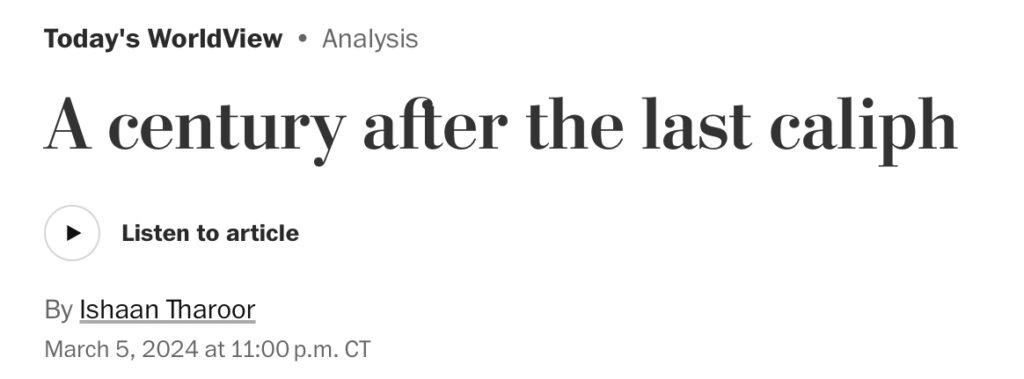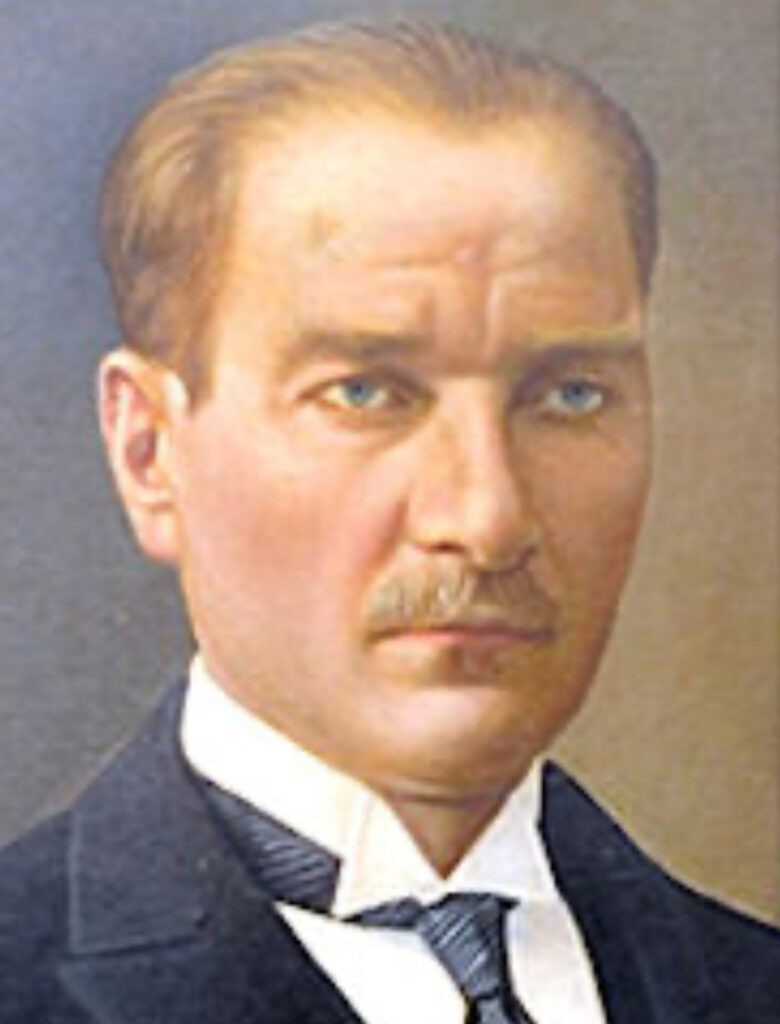Once Upon a Time
In early March 2024, the Washington Post columnist, Ishaan Tharoor, observed that 100 years has passed since the abolition of caliphate, an “institution that had prevailed in various forms for centuries, stretching back to the founding of Islam.” The caliphate’s end followed World War I’s destruction of the Ottoman empire and the post-war termination of the sultanate. By 1924, an empire hundreds of years old—and its political and religious structures of leadership—was gone.

The demise of the Ottoman empire, sultanate, and caliphate had been many decades in the making. Historians often explain that decline and fall as a consequence of Ottoman political and religious institutions and leaders failing to adjust effectively to the surging power and ideas of Western countries across the nineteenth century and into early twentieth century.
For example, Tharoor quoted The Economist observing on March 8, 1924, that the caliphate’s end “marks an epoch in the expansion of Western ideas over the non-Western world[.]” In that framing, the caliphate’s dissolution symbolized a decisive end to a clash of civilizations between Europeans and Ottomans that had unfolded over the previous century, if not longer.

From Osman Mehmed to Mustafa Kemal
That clash of civilizations plays a critical role in my novel, A Court at Constantinople, set in 1859, especially for the main Ottoman character, Osman Mehmed. The impact of European political, economic, and military power on the Ottoman empire torments Mehmed—from his childhood escape from the Russian invasion that triggered the Crimean war to being coerced as a law student to work for the British Supreme Consular Court at Constantinople.
Through it all, Mehmed remains defiant and determined to find reforms that allow political and religious leaders to change from within, on Ottoman and Islamic terms, rather than capitulating to European ideas and power. He writes a manifesto laying out his thinking for reforms. He critiques how sultans exercised political power and, as caliph, religious authority—ideas that could put him in danger, and eventually do. But he fears that continuation of the status quo would lead, at some point, to the end of the sultan’s power and diminution of Islam’s role in Ottoman law, justice, and society.
In developing Mehmed’s character and role in the novel, I know that events after 1859 reflect his fears more than his faith in reform through Ottoman-Islamic self-determination. I foreshadow that outcome by having Mehmed write his manifesto in a British gaol cell. Those choices align the novel with outcomes that emerged from the clash of European and non-European civilizations around the world in the latter half of the nineteenth century and early part of the twentieth century.
The demolition of the Ottoman empire during World War I—and the subsequent termination of the sultanate, founding of a secular Turkish republic, and ending of the caliphate—represents a particularly dramatic moment in this history of civilizational competition. That transformation unfolds in the hands of a Turkish nationalist, Mustafa Kemal—later known as Ataturk (father of the Turks), rather than through European imperial machinations, as happened in areas once ruled by the Ottomans, such as the Middle East. Ataturk was no British or French puppet, but the comprehensive modernization of his nation owed much to Western ideas and influences.

The novel obliquely acknowledges what is to come with Ataturk. As James Bingham, a young English barrister newly arrived in Constantinople, travels by carriage for an audience with the British ambassador, he locks “eyes with a young Turkish man on the roadside waiting for the carriage to pass. The man spat at the carriage, his ice-blue eyes filled with reproach and defiance.” Those “ice-blue eyes” are a figurative link to Ataturk, whose piercing blue eyes were one of his striking features.
What If?
In his Washington Post article, Tharoor explores some of the consequences of the abolition of the Ottoman caliphate, such as the emergence of militant Islamism in the twentieth century and the violent attempt by the Islamic State in the twenty-first century to reestablish a caliphate. He describes a counterfactual offered by a Turkish pundit, Mustafa Akyol: “What if the caliphate had endured as an autonomous, spiritual entity, somewhat along the lines of the Vatican in the newly invented Italian republic of the 19th century?”
That vision of an alternative history for the caliphate connects with what, in my novel, Mehmed seeks in reform—another way between all-encompassing Westernization and more enervating ossification of Ottoman political and religious institutions. Tharoor notes that Ottoman leaders had “embarked on major liberalizing reforms in the late 19th century,” reforms that are beginning when my novel takes place. However—as the end of the empire, sultanate, and caliphate attest—those reforms did not produce another way for the Ottoman peoples.
Mehmed’s fate in the novel also hints that his vision for the Ottomans will not come to pass, but you will need to read the story to find out what happens to a young man filled with reproach and defiance facing a world of change and turmoil.